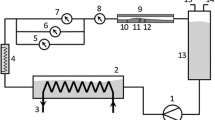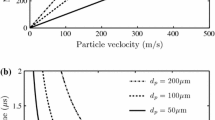Abstract
A high-magnification and high-resolution imaging technique was developed for the supercritical fluid antisolvent (SAS) precipitation process. Visualizations of the jet injection, flow patterns, droplets, and particles were obtained in a high-pressure vessel for polylactic acid and budesonide precipitation in supercritical CO2. The results show two regimes for particle production: one where turbulent mixing occurs in gas-like plumes, and another where distinct droplets were observed in the injection. Images are presented to demonstrate the capabilities of the method for examining particle formation theories and for understanding the underlying fluid mechanics, thermodynamics, and mass transport in the SAS process.







Similar content being viewed by others
References
Armellini FJ, Tester JW (1994) Precipitation of sodium chloride and sodium sulfate in water from sub- to supercritical conditions: 150 to 550°C, 100 to 300 bar. J Supercrit Fluids 7:147–158
Bleich J, Cleinebudde P, Muller BW (1994) Influence of gas density and pressure on microparticles produced with the ASES process. Int J Pharm 106:77–84
Chattopadhyay P, Gupta RB (2000) Supercritical CO2-based production of fullerene nanoparticles. Ind Eng Chem Res 39:2281–2289
Chattopadhyay P, Gupta RB (2003) Supercritical CO2-based production of silica nanoparticles using water-in-oil microemulsions. Ind Eng Chem Res 42:465–472
Chavez F, Debenedetti PG, Luo JJ, Dave RN, Pfeffer R (2003) Estimation of the characteristic time scales in the supercritical antisolvent process. Ind Eng Chem Res 42:3156–3162
Chen AU, Basaran OA (2002) A new method for significantly reducing drop radius without reducing nozzle radius in drop-on-demand drop production. Phys Fluids 14(1):L1–L4
Chigier N (1991) Optical imaging of sprays. Prog Energy Combust Sci 17:211–262
Dixon DJ, Johnston KP, Bodmeier RP (1993) Polymeric materials formed by precipitation with a compressed fluid antisolvent. AICHE J 39(1):127–139
Fang Z, Kozinski JA (2001) Phase changes of benzo(a)pyrene in supercritical water combustion. Combust Flame 124:255–267
Griffith AT, Park Y, Roberts CB (1999) Separation and recovery of nylon from carpet waste using a supercritical fluid antisolvent technique. Polym-Plast Tech Eng J 38(3):411–431
Kerst AW, Judat B, Schlunder EU (2000) Flow regimes of free jets and falling films at high ambient pressure. Chem Eng Sci 55:4189–4208
Kompella UB, Koushik K (2001) Preparation of drug delivery systems using supercritical fluid technology. Crit Rev Thera Drug Carr Syst 18(2):173–199
Lefebvre AH (1989) Atomization and sprays. Hemisphere, New York
Lengsfeld CS, Delplanque JP, Barocas VH, Randolph TW (2000) Mechanism governing microparticle morphology during precipitation by a compressed antisolvent: atomization vs. nucleation and growth. J Phys Chem B 104(12):2725–2735
Liu H (2000) Science and engineering of droplets. Noyes Publications, New Jersey
Luo JJ, Shen Y, Zhu C, Dave R, Pfeiffer R, Debenedetti PG, Khusid B (2001) In situ optical studies on drop/particle formation under supercritical conditions. In: Proceedings of the AIChE annual meeting 2001, Reno, Nevada, November 2001
Marioth E, Koenig B, Krause H, Loebbecke S (2000) Fast particle size and droplet size measurements in supercritical CO2. Ind Eng Chem Res 39:4853–4857
Martin TM (2000) Phase behavior and particle formation of polymers in supercritical fluid solvents. PhD dissertation, Auburn University, Alabama
Martin TM, Bandi N, Shulz R, Roberts CB, Kompella UB (2002) Preparation of budesonide and budesonide-PLA microparticles using supercritical fluid precipitation technology. AAPS Pharm Sci Tech 3(3):E18
Mawson S, Kanakia S, Johnston KP (1997) Coaxial nozzle for control of particle morphology in precipitation with a compressed fluid antisolvent. J Appl Polym Sci 64:2105
Mayer W, Tamura H (1996) Propellant injection in a liquid oxygen/gaseous hydrogen rocket engine. J Propul Power 12(6):1137–1147
Notz PK, Chen AU, Basaran OA (2001) Satellite drops: unexpected dynamics and change of scaling during pinch-off. Phys Fluids 13(3):549–552
Park Y, Curtis CW, Roberts CB (2002) Formation of nylon particles and fibers using precipitation with a compressed antisolvent. Ind Eng Chem Res 41(6):1504–1510
Randolph TW, Randolph AD, Mebes M, Yeung S (1993) Sub-micrometer-sized biodegradable particles of poly (L-lactic acid) via the gas antisolvent spray precipitation process. Biotechnol Prog 9:429–435
Reverchon E, Della Porta G (2001) Supercritical fluids-assisted micronization techniques. Low-impact routes for particle production. Pure Appl Chem 73(8):1293–1297
Shekunov BY, Hanna M, York P (1999) Crystallization process in turbulent supercritical flows. J Cryst Growth 198(199):1345–1351
Shekunov BY, Baldyga J, York P (2001) Particle formation by mixing with supercritical antisolvent at high Reynolds numbers. Chem Eng Sci 56:2421–2433
Stephens AP (2003) Visualization of particle formation processes in supercritical fluids. M.S. thesis, Auburn University. Alabama
Sun Y (2002) Supercritical fluid technology in materials science and engineering syntheses, properties, and applications. Marcel Dekker, New York
Werling JO, Debenedetti PG (1999) Numerical modeling of mass transfer in the supercritical antisolvent process. J Supercrit Fluid 16:167–181
Werling JO, Debenedetti PG (2000) Numerical modeling of mass transfer in the supercritical antisolvent process: miscible conditions. J Supercrit Fluid 18:11–24
Wilkes ED, Phillips SD, Basaran OA (1999) Computational and experimental analysis of dynamics of drop formation. Phys Fluids 11(12):3577–3598
York P, Hanna M (1996) Particle engineering by supercritical fluid technologies for powder inhalation drug delivery. In: Proceedings of the respiratory drug delivery V conference, Phoenix, Arizona, April/May 1996, pp 231–239
Acknowledgements
Financial support from the National Science Foundation (CTS-0207781) is gratefully acknowledged.
Author information
Authors and Affiliations
Corresponding author
Rights and permissions
About this article
Cite this article
Bell, P.W., Stephens, A.P., Roberts, C.B. et al. High-resolution imaging of the supercritical antisolvent process. Exp Fluids 38, 708–719 (2005). https://doi.org/10.1007/s00348-005-0933-4
Received:
Revised:
Accepted:
Published:
Issue Date:
DOI: https://doi.org/10.1007/s00348-005-0933-4




